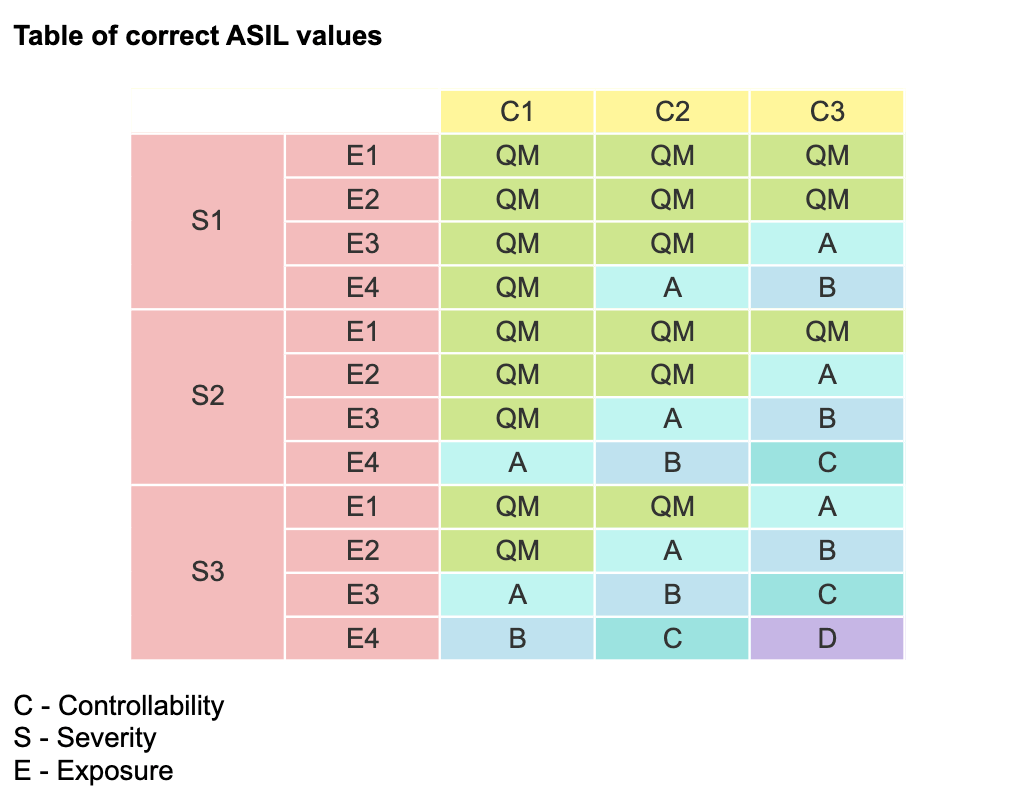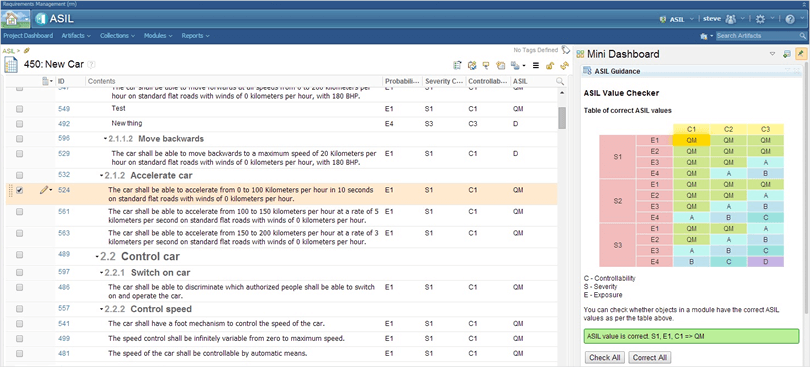
Automotive Certification Standards - Software Solutions
Within the automobile industry, functional safety as a process is based on the guidelines specified by ISO 26262, an international safety standard for automotive.
This page describes how we help customers by using the best practices and IBM Tools to achieve compliance in the automotive industry.
ISO 26262 Process Support
ISO 26262 standard defines functional safety as the “absence of unreasonable risk due to hazards caused by malfunctioning behavior of electrical/electronic systems”.
For ISO 26262 compliance; a functional safety consultant identifies and assesses hazards (safety risks). These hazards are then categorized based on their criticality factor under the Automotive Safety Integrity Level (ASIL) under ISO 26262. Such a clear classification of hazards helps to :
- Establish various safety requirements to mitigate the risks to acceptable levels
- Smoothly manage and track these safety requirements
- Ensure that standardized safety procedures have been followed in the delivered product.

The IBM Rational Solution for Automotive Engineering - ISO-26262 is a set of best practices to help organizations develop products that must comply with the ISO-26262 functional safety standard.
The scope of these practices covers areas that are described by ISO-26262, relating to the management of functional safety, concept, system engineering, and software development. They have been developed to support the incremental adoption of processes, practices, and tools, thereby reducing the time to value for process improvement initiatives.
Learn by watching videos
ASIL and its Support with IBM
The safety lifecycle of any automotive component, within the ISO 26262 standard starts with the definition of the system and its safety-criticality at the vehicular level.
This is done through hazard analysis and risk assessment for the corresponding automotive component (hardware/ software), necessary for the determination of the Automotive Safety Integrity Level (ASIL).
Hence, the determination of ASIL forms the very first phase of the automotive system development. Here, basically, all potential scenarios of hazards and dangers are evaluated for a particular automotive component, the occurrence of which can be critical for vehicle safety.
For example, unexpected inflation of airbags or failures of brakes is a potential safety hazard that should be assessed and managed in advance. This step is followed by identifying the safety goals for each component, which are then classified according to either the QM or ASIL levels, under the ISO 26262 standard.

What are safety goals?
Safety goals are the level of safety required by an automotive component to function normally without posing any threats to the vehicle.
For example, for a car door, the safety goal could be both the importance of having it opened or closed depending on which action is safe under a particular condition.

During instances of fire inside the vehicle or a flood, the safety goal would be to have the car door opened as quickly as possible so that the passengers can escape.

On the contrary, while the vehicle is moving fast, the safety goal related to the door will be to remain closed.
The accidental opening of the door of a moving car could lead to greater risks.
ASIL Value checker
IBM Rational DOORS Next Generation provides a client extension API that you can use to extend the functionality of the tool by using technologies that you already know, such as HTML and JavaScript. You can create and host a catalog of extensions on a server so that your team can share them.
The following image shows an extension that can check attribute values that are related to the ISO 26262 ASIL standard.
FMEA
Watch the following video, which shows how to capture failure mode and effects analysis in DOORS Next Generation using templates and extensions.
If you want learn more read our article about FMEA
IBM Rational Solution for Automotive Engineering - HIS ASPICE (Beta)
This solution provides guidance and the means to capture and view an ASPICE assessment in real-time. It applies to HIS-ASPICE assessors and companies performing HIS-ASPICE assessments.
Capturing their current HIS-ASPICE capabilities levels allows them to easily determine gaps in their process. Implementation of HIS-ASPICE is helped and supported further by the adoption of the IBM CLM suite of tools.
Learn by watching videos
Following is the series of videos with a discussion on how IBM tools can help with ASPICE compliance.
Hazard and Risk Analysis (HARA)
For any particular failure of a defined function at the vehicle level, a hazard and risk analysis (HARA) helps to identify the intensity of risk of harm to people and property.
This Analysis can be provided only in the Requirements management tool (IBM Rational doors Generation) but also be modeled in the Modeling domain.

Model-Based Systems and Software Engineering for ISO 26262
BTC Embedded Systems AG provided the following documentation for the IBM® Rational® Rhapsody® Kit for ISO 26262, IEC 61508, IEC 62304, and EN 50128. In addition, the certificate and report for the certificate are also available for this Rational Rhapsody kit.
These documents are available in PDF format.
Note
Information concerning non-IBM products was obtained from the suppliers of those products, their published announcements, or other publicly available sources. IBM has not tested those products and cannot confirm the accuracy of performance, compatibility, or any other claims that are related to non-IBM products.
| Document title and link | Description |
|---|---|
| Rhapsody Kit for DO-178B/C Overview | Provides an overview of the various artifacts in the Rational Rhapsody Kit for DO-178B/C. |
| IBM Rational Rhapsody Reference Workflow Guide | Focuses on model-based development (MBD) with Rational Rhapsody in safety-related projects. |
| IBM Rational Rhapsody TestConductor Add On Reference Workflow Guide | Describes a reference workflow for testing activities in a model-based development process using Rational Rhapsody and Rational Rhapsody TestConductor Add On. It complements the "IBM Rational Rhapsody Reference Workflow Guide." |
| IBM Rational Rhapsody TestConductor Add On Safety Manual | Serves as a brief safety manual when using Rational Rhapsody TestConductor Add On for testing activities in a model-based development process when developing safety-related software. |
| IBM Rational Rhapsody TestConductor Add On Qualification Kit for DO 178B-C Overview | Provides guidance to qualify Rational Rhapsody TestConductor Add On for DO-178B and DO-178C projects. |
| Readme file | Provides instructions on which document to start with first. |
Check out also: Model-Driven Development for Safety-Critical Software

Fault Tree Analysis
"8 steps to safety"




1. Identify the hazards
2. Determine risks
3. Define the safety measures
4. Create safety requirements




5. Create safe designes
6. Implement safety
7. Ensure the safety process
8. Test

1. Identify the hazards

2. Determine risks

3. Define the safety measures

4. Create safety requirements

5. Create safe designes

6. Implement safety

7. Ensure the safety process






